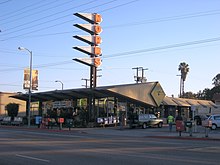Our website is made possible by displaying online advertisements to our visitors.
Please consider supporting us by disabling your ad blocker.
Googie architecture

Googie architecture (/ˈɡuːɡi/ ⓘ GOO-ghee[1]) is a type of futurist architecture influenced by car culture, jets, the Atomic Age and the Space Age.[2] It originated in Southern California from the Streamline Moderne architecture of the 1930s, and was popular in the United States from roughly 1945 to the early 1970s.[3]
Googie-themed architecture was popular among roadside businesses, including motels, coffee houses and gas stations. The style later became widely known as part of the mid-century modern style, elements of which represent the populuxe aesthetic,[4][5] as in Eero Saarinen's TWA Terminal. The term Googie comes from the now-defunct Googies Coffee Shop in Hollywood[6] designed by John Lautner.[7] Similar architectural styles are also referred to as Populuxe or Doo Wop.[8][9]
Features of Googie include upswept roofs, curvilinear, geometric shapes, and bold use of glass, steel and neon. Googie was also characterized by Space Age designs symbolic of motion, such as boomerangs, flying saucers, diagrammatic atoms and parabolas, and free-form designs such as "soft" parallelograms and an artist's palette motif. These stylistic conventions represented American society's fascination with Space Age themes and marketing emphasis on futuristic designs. As with the Art Deco style of the 1910s–1930s, Googie became less valued as time passed, and many buildings in this style have been destroyed. Some examples have been preserved, though, such as the oldest McDonald's stand (located in Downey, California).
- ^ Ulaby, Neda (July 14, 2011). "Out Of This World: Designs Of The Space Age". NPR Morning Edition. Retrieved June 5, 2016.
- ^ Friedlander, Whitney (May 18, 2008). "Go on a SoCal hunt for Googie architecture". Baltimore Sun. Los Angeles Times. Archived from the original on January 6, 2014. Retrieved February 11, 2009.
It was the 1950s. America was a superpower, and the Los Angeles area was a center of it. The space race was on. A car culture was emerging. So were millions of postwar babies. Businesses needed ways to get families out of their automobiles and into coffee shops, bowling alleys, gas stations and motels. They needed bright signs and designs showing that the future was now. They needed color and new ideas. They needed Googie.
- ^ Novak, Matt (June 15, 2012). "Googie: Architecture of the Space Age". Smithsonian.com. Archived from the original on June 5, 2020. Retrieved May 23, 2015.
- ^ Stager, Claudette; Carver, Martha (2006). Looking Beyond the Highway: Dixie Roads and Culture. Univ. of Tennessee Press. p. 158. ISBN 978-1-57233-467-0. Retrieved August 9, 2013.
- ^ Cotter, Bill; Young, Bill (2004). "Populuxe and Pop Art". The 1964-1965 New York World's Fair. Arcadia Publishing. p. 51. ISBN 978-0-7385-3606-4. Retrieved August 9, 2013.
- ^ Nelson, Valerie J. (April 26, 2011). "Eldon Davis dies at 94; architect designed 'Googie' coffee shops". Los Angeles Times. Retrieved May 15, 2011.
- ^ John Lautner Why Do Bad Guys Always Get The Best Houses? October 31 by Rory Stott ArchDaily
- ^ Doo Wop Motels: Architectural Treasures of The Wildwoods by Kirk Hastings 2007, p.2
- ^ Cite error: The named reference
leaguewas invoked but never defined (see the help page).
Previous Page Next Page


